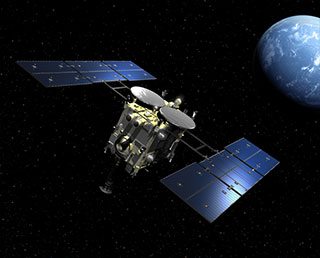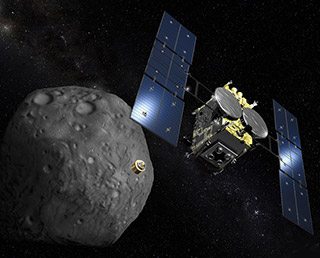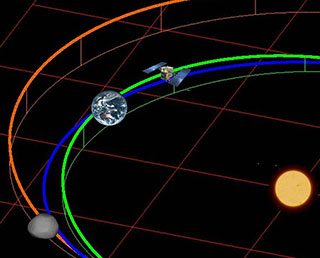Topics List
Nov. 2, 2015 Updated
Hayabusa2 set for Earth swing-by! Your support messages welcomed.
|
The Asteroid Explorer “Hayabusa2” will fly near the Earth to perform an Earth swing-by utilizing the Earth’s gravity on Dec. 3 (Thur.) for its orbit control. |
 |
|---|
Oct. 5, 2015 Updated
“Ryugu” was selected as name of Hayabusa2 target asteroid
|
Asteroid 1999 JU3, a target of the Asteroid Explorer “Hayabusa2,” was named “Ryugu”. |
 |
|---|
Sep. 2, 2015 Updated
Hayabusa2 additional ion engine operation for Earth swing-by
|
On Sept. 1 (Tue.) and 2 (Wed.), the ion engine of the Hayabusa2 was additionally operated in order to increase the orbit control accuracy for the Earth swing-by. |
 |
|---|
Jul. 22, 2015 Updated
Naming Proposal Campaign: Become a godparent of asteroid “1999 JU3”, destination of Hayabusa2!
|
JAXA is holding a naming proposal campaign to christen the asteroid “1999 JU3″,which the Hayabusa2 is scheduled to visit in June or July 2018. Why don’t you try to become a godparent of the asteroid? August 31, 2015 at 11:59 p.m. (Japan Standard Time). (Extended from 10:00) |
 |
|---|
Jun. 8, 2015 Updated
Hayabusa2 second ion engine continuous operation completed
|
The Hayabusa2 has been continuously operating its ion engine for the second time since June 2, and successfully completed its operations at 0:25 a.m. on June 7 (Japan Standard Time.) The second continuous operation lasted for 102 hours as scheduled. |
 |
|---|
Apr. 10, 2015 Updated
Baton pass to new Hayabusa2 project manager
|
The Hayabusa2 is stably flying in space. The new fiscal year has just started in Japan, and JAXA is taking a new step as we became a National Research and Development Agency from the previous independent administrative agency. The Hayabusa2 project is also taking a fresh step with a new team, including handing the baton over to a new project manager. All members of the project are engaged in the mission with a fresh mindset. Message from New Project Manager Yuichi TsudaThe Hayabusa2 is stably flying since its launch and smoothly continuing it interplanetary cruising. I can, therefore, take over the mission at the best condition from my predecessor, former Project Manager Hitoshi Kuninaka, who led the development of the project. With many operation experts joining the new team, we would like to successfully send the Hayabusa2 to the asteroid 1999JU3, and have it come home safely. Message from Former Project Manager Hitoshi KuninakaAs the development phase is over, Hayabusa2’s deep space exploration has started. Photo: left: New Project Manager Yuichi Tsuda, right: Former Project Manager Hitoshi Kuninaka |
 |
|---|
Mar. 5, 2015 Updated
Hayabusa2 initial functional confirmation completed and moved to cruising phase to asteroid
|
The Asteroid Explorer “Hayabusa2,” launched on Dec. 3, 2014, completed its initial functional confirmation period of about three months. The explorer was moving to the cruising phase on March 3 while heading to the asteroid “1999 JU3.” |
 |
|---|
Feb. 3, 2015 Updated
Hayabusa2 in great shape – Initial functional confirmation going smoothly
|
The Hayabusa2, launched on Dec. 3, 2014 (JST), is now undergoing the initial functional confirmation. Basic operations and performance of onboard instruments and ground systems have been tested one by one as of the end of January.
The explorer is currently in good shape. *1 The autonomous operation is automatic control of an engine without instructions from the ground. |
 |
|---|
Dec. 5, 2014 Updated
Hayabusa2 flying smoothly!
|
JAXA confirmed the completion of a sequence of the important operations for the “Hayabusa2” mission. With this confirmation, the critical operation phase* of the Hayabusa2 was completed. We would like to express our sincere appreciation to all parties and personnel concerned for their support and cooperation with the Hayabusa2 launch and tracking control operations. Please send your support messages for the mission! (you can send a message from Hayabusa2 Project page or tweet with hashtag #hayabusa2 ). |
 |
|---|
Dec. 3, 2014 Updated
“Hayabusa2” successfully launched!
|
H-IIA F26 with the Asteroid Explorer “Hayabusa2” onboard launched at 1:22:04 p.m. on Dec 3, 2014 (JST) from the Tanegashima Space Center. |
 |
|---|
Nov. 30, 2014 Updated
“Hayabusa2” Launch rescheduled to 1:22:04 p.m. on December 3 (Mon.) 2014
|
Mitsubishi Heavy Industries, Ltd. and JAXA have decided to postpone the launch of “Hayabusa2” and piggyback payloads by the H-IIA F26 to 1:22:04 p.m. on Dec 3 (Wed. JST). The live launch report will begin at 12:25 p.m. on December 3 (Mon. , JST). The report will be broadcast through the Internet. We decided to postpone as a result of the go/no go decision meeting today which carefully checked the weather forecast and found that strong wind exceeding the weather restrictions was projected around the launch pad at the scheduled launch time on the previous schedule launch day of Dec. 1 (Mon.), 2014. |
 |
|---|
Nov. 29, 2014 Updated
“Hayabusa2” Launch rescheduled to 1:22:43 p.m. on December 1 (Mon.) 2014
|
The launch of the Asteroid Explorer “Hayabusa2” and three micro piggyback payloads by the H-IIA Launch Vehicle No. 26 was rescheduled at 1:22:43 p.m. on December 1 (Mon. Japan Standard Time, JST) after carefully studying the weather conditions. |
 |
|---|
Nov. 28, 2014 Updated
Hayabusa2 launch postponement
|
H-IIA Launch Vehicle No.26 with the Asteroid Explorer “Hayabusa2” onboard has been rescheduled as clouds including a freezing layer that exceeds the restrictions for suitable weather are forecast to be generated at around the scheduled launch time on November 30 (Sun.), 2014 (Japan Standard Time.) |
 |
|---|
Nov. 27, 2014 Updated
New movie “Ready to Face New Challenges -Hayabusa2- “
|
The new video clip titled “Ready to Face New Challenges -Hayabusa2- ” was uploaded to the YouTube. |
 |
|---|
Nov. 4, 2014 Updated
“Hayabusa2″ Launch Live Broadcast (by H-IIA F26)
|
JAXA will broadcast a live report of the Asteroid Explorer Hayabusa2’s launch by the H-IIA Launch Vehicle No.26 (H-IIA F26) from the Tanegashima Space Center. The report will cover launch events from the liftoff to the payload separation from the launch vehicle. Program summaryThe broadcast program consists of two parts. The first half mainly focuses on launch events prior to and after liftoff. Then the latter half covers events before and after the Hayabusa2’s separation from the launch vehicle. *Please be aware that the time schedule of the program is subject to change due to progress of the launch operations. Program contentsPart I
*The scheduled launch time is 1:24 p.m. Part I broadcast day and time
* Images of piggyback payloads’ separation will NOT be broadcast. Part II broadcast day and time Internet live broadcastJAXA will distribute our live report through the following Internet channels. * The copyright of the live broadcast belongs to JAXA. We are welcoming support messages at the special site. Please send your messages for the mission, or tweet it. To tweet on Twitter, please attach the hashtag, #hayabusa2
. |
 |
|---|
Sep. 30, 2014 Updated
New voyager to travel deep into space! Hayabusa2 to be launched on Nov. 30
|
The launch date and time for the H-IIA Launch Vehicle No. 26 (H-IIA F26) with the Asteroid Explorer “Hayabusa2” onboard was decided to be at 1:24:48 p.m. on November 30 (Sunday), 2014 (Japan Standard Time)*. The latest information about “Hayabusa2” and its launch preparation status will be updated on the “Hayabusa2” project page. |
 |
|---|
Sep. 5, 2014 Updated
Hayabusa2 revealed to the media
|
The Asteroid Explorer “Hayabusa2” was shown to the media at Sagamihara Campus on August 31, 2014. The Hayabusa2 is the successor of the Hayabusa, which captured sample particles from an asteroid and returned to the Earth in 2010. By capitalizing on the experience of the Hayabusa, the Hayabusa2 aims at acquiring samples and bringing them back from the C-type asteroid “1999JU3” to elucidate the origin and evolution of the solar system and material for life. “I am bracing for the new voyage of the Hayabusa2.” said Project Manager Kuninaka. |
 |
|---|
Nov. 20, 2013 Updated
Hayabusa2 Small Carry-on Impactor undergoes test
|
Hayabusa2’s Small Carry-on Impactor (SCI) underwent a test in October, 2013. Hayabusa2 SCI test [JAXA Digital Archives] |
 |
|---|
Jul. 17, 2013 Updated
Campaign extended till August 9 (Fri.)!
– Let’s attach your name and message to Hayabusa2 –
|
JAXA has been conducting a campaign to attach names and messages of Hayabusa2 mission supporters from all over the world to the space probe! We would love to share this superb moment and feeling of achievement with you through this campaign. We would like to express our sincere appreciation to all of you who joined the campaign since it began on April 10 till today. Also we appreciate your cooperation for registering or sending your names and messages on time. Thank you very much. As we read the support messages for the Hayabusa2, we strongly felt that we would like to support this mission by being united with more of you. We are looking forward to hearing from more of you as an individual and/or as a community such as a family, a school or a company, and/or with your friends! With the Hayabusa2 |
 |
|---|
Jun. 14, 2013 Updated
Hayabusa2 completes first integration test
|
All processes of the Hayabusa2’s first integration test since January this year were completed on June 7. The test aimed at installing all onboard devices onto the satellite structure and confirming interfaces among them. During the mass property measurement, the last process of the integration test, the “Hayabusa2” exposed its full shape for the first time with all devices for the test installed. |
 |
|---|
Mar. 29, 2013 Updated
Hayabusa2 can carry your names and messages to space
|
JAXA is holding a campaign to record your names, messages and illustrations onboard the asteroid probe Hayabusa2. |
 |
|---|
Dec. 27, 2012 Updated
Hayabusa2 revealed before the first integration test
|
On Dec. 26, the Hayabusa2 was revealed at the Sagamihara Campus. As its design was completed this spring, the Hayabusa2 will soon undergo the first integration test to confirm the interfaces among onboard devices as well as between the devices and the explorer’s bus after assembling them onto the bus. Also, the flight models of the Hayabusa2’s main body and solar array paddles have already been manufactured, thus those models will be verified through a vibration test. In addition, the exposed environment for the onboard devices will also be measured. JAXA is developing the Hayabusa2 to be ready for its launch in FY2014. |
 |
|---|
This entry passed through the Full-Text RSS service – if this is your content and you’re reading it on someone else’s site, please read the FAQ at fivefilters.org/content-only/faq.php#publishers.
Comments are closed.